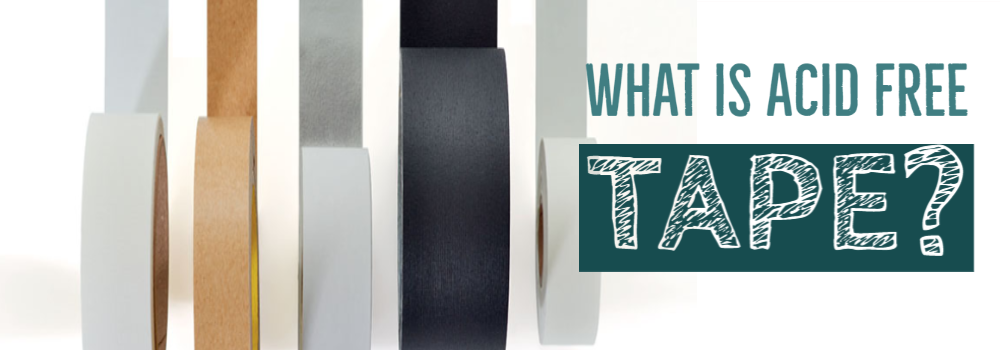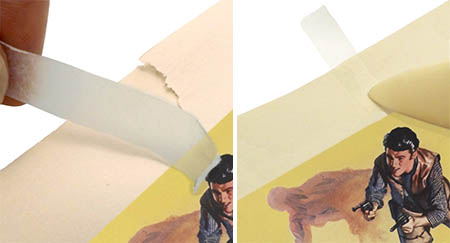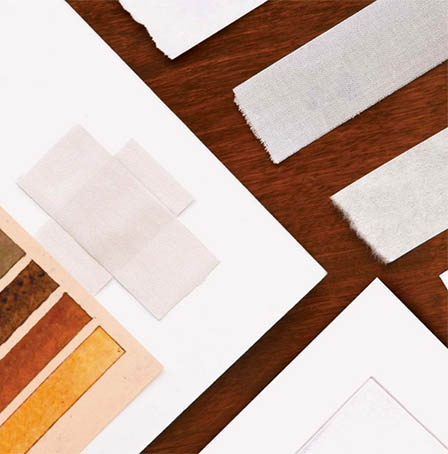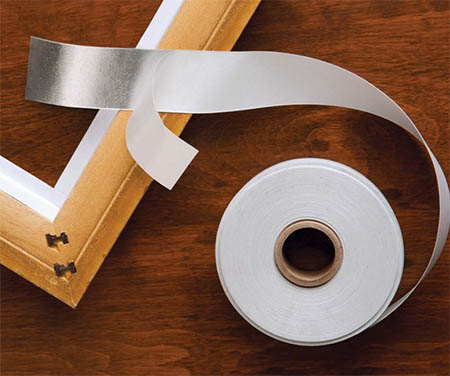What is acid free tape? What is archival tape? and why should you use it

The results of using the wrong type of tape on works of art, books and documents can be disastrous. Even if the usage was well intentioned, using the wrong tape can cause harm in the long term. So, what is the difference between ‘normal’ tapes and acid free tapes? What’s archival tape? And how do you prevent a disaster?
Types of tape
When we talk about acid-free tape here at PEL, we make sure that the complete structure of the tape is acid free, or to put it another way, pH neutral. That’s important to bear in mind, as tape can have more than one component. These are the types of tape available:
Pressure sensitive tape – often called self-adhesive tape (or scotch tape / Sellotape / masking tape) has an adhesive applied to the tape’s carrier material. The carrier (or backing) may also have a primer applied, and sometimes a release coat to stop it sticking to itself. Once applied the tape requires a little pressure to ensure adhesion.
Gummed Tapes – These tapes have an adhesive applied to the carrier material which usually requires water to activate the adhesive. These are generally easier to remove (reversible) if required.
Non-Adhesive tapes – These tapes are simply continuous strips of material that can be adhered with the user’s choice of adhesive.
Acid free tape adhesives

There are a number of different types of adhesives that have been, and are used, on pressure sensitive tapes over the annals of history. The adhesive is one of the key elements in a pressure sensitive tape, or gummed tape, here are the issues:
-
One of the problems with aging non-archival tapes is that the adhesive will gradually dry out and fail, defeating the object of its application, the repair is no longer fixed. Archival tapes from PEL are designed not to dry out or shrink.
-
Old non-archival adhesives can degrade, turn yellow and stain the paper they have been applied to. This staining can be difficult if not impossible to remove.
-
Non-archival tapes aren’t generally reversible. An important aspect of an archival tape is that it can be removed without harming the paper, and are therefore, reversible. This is not a case of simply tearing it away, a solvent would be applied, but it does mean it can be removed in the future.
-
Adhesives in standard tapes can contain acidic materials which will weaken and eventually destroy the paper it has been applied to. Some adhesives may release acidic gasses (called off-gassing) as they degrade causing damage to any paper stored around it. Acid free adhesive tapes do not behave this way.
So, as you can see, when selecting an acid-free tape you also need to make sure that; the adhesive will not dry out and fail, will not turn yellow and stain your paper, that it can be removed in the future – as well as being acid-free.
For conservation grade repairs on very fragile or valuable items, it may be necessary to consider a non-adhesive tape and appropriate acid free conservation grade adhesive, like wheat starch. For these types of repairs we always recommend consulting with a conservator. The conservator will be able to recommend the best adhesive and tape material for your repair.
> | View all acid free tapes here click here
Acid free tape
carrier materials
When talking about being acid-free, as important as the adhesive, is the carrier (or backing) of the tape. If the adhesive is acid free but the carrier isn’t, then the tape isn’t acid free! There are various carrier materials that are acid free and used in our tapes, each designed for different applications. Here are some of the materials available:
-
Japanese paper tapes – Many different types and weights for a range of purposes, from invisible repairs, to hinging heavy artwork
-
Linen tapes - Heavy duty tapes that are usually used for reinforcement and hinging artwork
-
Acid free paper tapes (pulp) - Usually for repairing paper and lighter hinging work often buffered to prevent acidity
-
Polyester tapes – for joining clear films
-
Foil/Copper tapes - Acts as a barrier material, used in frame backing, packaging and storage applications
-
Tyvek tapes - Very strong, used for joining Tyvek, hinging artwork, reinforcement and frame backing

Acid free tapes for paper repairs

The most common requirement for an acid free tape is to fashion a repair in paper. That may be a work of art, book, newspaper, certificate, photograph, map, poster etc.
For simple repairs in tears in paper that’s generally in good condition and are not of a significantly high value, pressure sensitive acid free mending tapes work well. These archival quality tapes can be applied easily and form strong and barely visible repairs in most papers. They are not recommended for very high value items as they can be more difficult to remove, should that ever be required. Here are our recommendations for acid free tapes for these types of repair:
> | Arcare acid free paper repair tapes
> | Filmoplast acid free paper repair tapes
For repairs on very fragile papers, or items of significant value, it is best to consult with a professional conservator. The preferred type of tape for these repairs is Japanese paper tape, or sheets (which are cut or torn to shape). Japanese paper is naturally acid free and is applied using a conservation grade adhesive.
For repairs that require a stronger tape, I.e. repairs to book spines, an acid free cloth tape or Tyvek tape would be suitable. Again, for repairs on items of significant value, a conservator should be consulted.
Acid free tapes for hinging artwork

When hinging artwork, gummed tapes are usually preferred over a pressure sensitive tape. This means the hinge can be more easily removed if required as the adhesive is water based, therefore can be removed without harsher chemicals.
Here are the acid free gummed hinging tapes
> | Arcare Gummed Acid Free Hinging Tape
> | Hayaku Acid Free Gummed Japanese Hinging Tape
> | Gummed Linen Hinging Tape
Conservators creating a conservation grade hinge will generally use a tape with their own choice of conservation grade adhesive. Japanese paper is ideal for this purpose as it is acid free and offers high strength meaning the hinge can be made from thinner material and still be secure. The thinness of the tape allows it to be used on artwork without being seen through the art.
Acid free Japanese paper conservation grade hinging tapes
> | Arcare Japanese Washi Mounting / Hinging Tape - 20gsm
> | Tengu Japanese Paper Tape - 7.3gsm
> | Deckled edge Japanese Hinging Tissue - 12gsm & 20gsm
> | Japanese Paper Tape - 9gsm
 Acid free tapes for sealing picture frames
Acid free tapes for sealing picture frames
Picture frames seal artwork in their own micro-environment, this can mean that using the wrong tape to hinge art (as above) and then seal into the frame, could lead to long term damage to the art inside. Frame sealing tapes serve to exclude dust, moisture, pests and other external contaminants. Standard tapes, like masking tape, are not suitable for conservation quality framing.
> | Acid Free Foil frame sealing tape
> | Acid Free Tyvek frame sealing tape
> | Acid Free Corrosion intercept frame sealing tape
So, why should you use an acid free tape?
As you can see, there are many types of acid free tape to perform a number of preservation tasks. It’s important that, when placing an item into a frame, storage, or preserving it for the future that you use an acid free tape to prevent damage. The degradation of paper is accelerated by acid and by using a tape with an acidic adhesive or carrier will cause damage, discolouration and weaken the item you’re trying to care for.